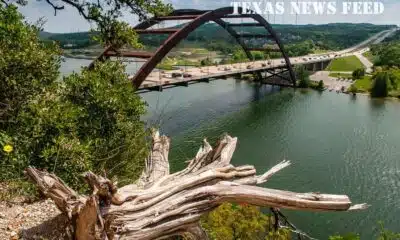News from the South - North Carolina News Feed
Wildfires across NC mostly caused by dry conditions, carelessness
As NC wildfires rage, many can be blamed on one thing: people. ‘We’re our own worst enemy,’ official says.
Dozens of wildfires are burning across the state following a stretch of unseasonably warm weather, high winds and low humidity.
And just like in years past, the majority of blazes can be traced to be one source: people.
Between Feb. 24 and March 3, the North Carolina Forest Service responded to a staggering 806 wildfires — all caused by humans — that burned more than 3,300 acres across the state.
[Subscribe for FREE to Carolina Public Press’ alerts and weekend roundup newsletters]
The latest occurred on Monday. Firefighters responded to a 123-acre wildfire along Millis Road, just west of Nine Mile Road at the Croatan National Forest in Carteret County.
While winds contributed to the fire’s initial growth, rain helped stop its progression. Firefighters worked on removing burning snags and logs around the perimeter. Crews will continue suppression efforts, checking for heat and reinforcing firelines.
Although what caused the fire hasn’t yet been determined, unattended campfires and discarded cigarettes are typically the main causes of many blazes this time of year.
“We’re our own worst enemy,” said Philip Jackson, a spokesman for the North Carolina Forest Service.
The heat is on
Human-caused forest fires present his state agency and other land managers with a crucial challenge: protecting the growing number of people living in areas where forest and development meet.
“The population is growing to the point where people are beginning to inhabit areas that were previously undeveloped wild forestland,” Jackson explained.
Such areas where the built environment intermingles with nature has been referred to as the “wildland-urban interface.” And North Carolina has more wildland-urban interface acres than any other U.S. state, presenting complex challenges for fire management and public safety.
Meanwhile, local, state and federal agencies work to contain ongoing blazes. Staffing shortages, however, are straining wildland firefighting resources.
A recent weekend saw a surge of wildfires. But the bump in activity, however, wasn’t unexpected, according to Jackson.

“It was a pretty weekend to be outside,” he said, “so we saw more wildfire starts from campfires and debris burns.”
The spring fire season usually lasts until May. During that time, the potential for blazes will be high. For the next several weeks, low humidity will transform vegetation and woody debris into kindling that’s easily ignited by a stray ember from a routine leaf burn on a windy afternoon.
What worries wildfire responders most are escaped residential brushfires that come from burning leaves or piles of yard debris.
The largest wildfire — so far — was caused by a wind-fallen power line on March 2 in Polk County. The blaze spread to 619 acres and was 91% contained three days later. It’s since been extinguished.
Jackson said that firefighters conducted a controlled, low-intensity fire on the perimeter of the blaze to limit its spread. The strategic fire allowed firefighters “to widen and strengthen containment lines,” he said. “When the fire reaches that area there’s nothing more to burn because it’s already cold and black.”
But that’s just one fire down. There are several more to contend with.
Wildfires take their toll
In the first half of the 20th century, the U.S. Forest Service and other forest managers feared outbreaks of destructive wildfires and snuffed out flames as quickly as possible. But researchers in the 1960s and 1970s demonstrated the benefits of letting wildfires burn — or using “prescribed fire,” which helped reverse decades of fire-suppression policies.
Although fires have meaningful ecological benefits to some forested landscapes, unplanned fires pose a potential danger to wildland firefighters and people who live on the edges of forests. Wildfire response is also expensive, requiring specialized personnel, incident command teams and heavy equipment, such as bulldozers and aircraft.
Of late, the U.S. Forest Service battled several blazes within each of its four national forests including the 20-acre McClure Road Fire in Cherokee County’s Nantahala National Forest; the 194-acre Hicks Cemetery Fire in Haywood County’s Pisgah National Forest; and Montgomery County’s 505-acre Fall Dam Fire in the Uwharrie National Forest.
The current fire in the Croatan National Forest is on the heels of a 114-acre blaze that occurred recently across the same area in coastal Craven County — a region that’s no stranger to wildfires.
In April 2023, the 35,000-acre Great Lakes Fire burned large swaths of highly-flammable pocosin swampland. That fire was, in part, contained by a fortunate shift in winds and the use of controlled fire to reduce fuel in between the highly flammable pocosins and clusters of homes along edges of the National Forest boundary.
In the Pisgah and Nantahala National Forest in Western North Carolina, rangers are particularly concerned about woody debris due to Hurricane Helene. Fighting wildfires in remote areas of the National Forest is complicated by steep terrain that makes it difficult to reach and contain flames.
To that end, the U.S. Forest Service and the Appalachian Trail Conservancy have partnered to remove fallen trees that may have commercial value in the Pisgah National Forest near the Appalachian Trail in McDowell, Burke, Yancey and Mitchell counties.

However, recent cuts to the Forest Service’s workforce may hamper the agency’s ability to properly do its job. In February, the Trump administration cut 3,400 U.S. Forest Service positions, representing 10% of the agency’s workforce.
In a statement, the U.S. Department of Agriculture told CPP that wildland firefighting positions are considered public safety jobs.
“Protecting the people and communities we serve, as well as the infrastructure, businesses and resources they depend on to grow and thrive, remains a top priority for the USDA and the Forest Service,” the agency said.
Feeling the burn
The U.S. Forest Service manages more than one million acres of public forest in North Carolina, but the majority of wildfires begin on private land. According to Jackson, 83% of the state’s forestland is privately owned.
“Private landowners are a huge stakeholder,” he said.
In addition to dry conditions and large fuel loads, staffing issues facing the North Carolina Forest Service are complicating fire prevention support and wildfire response.
“We continue to struggle with vacancies due to recruitment and retention issues,” Jackson admitted. “We’re doing the best we can to provide adequate firefighting coverage in areas that are prone to wildfire or more at risk.”
Jackson said the approach isn’t sustainable in the long term, especially during above-average fire seasons. The agency is seeking more funding for higher salaries to attract and retain firefighters.
In addition to the agency’s staffing issues, a recent incident in Eastern North Carolina emphasized a new problem facing firefighters: drones. A state-owned airtanker approaching a wildfire in Craven County was diverted in early March to avoid a collision with a drone hovering above the wildfire.
“We want folks to understand to never fly a drone near or around the wildfire,” Jackson said. “First and foremost it’s illegal, but it significantly hinders our ability to do our job.”
This article first appeared on Carolina Public Press and is republished here under a Creative Commons license.
The post Wildfires across NC mostly caused by dry conditions, carelessness appeared first on carolinapublicpress.org
News from the South - North Carolina News Feed
White House officials hold prayer vigil for Charlie Kirk
SUMMARY: Republican lawmakers, conservative leaders, and Trump administration officials held a prayer vigil and memorial at the Kennedy Center honoring slain activist Charlie Kirk, founder of Turning Point USA. Kirk was killed in Utah, where memorials continue at Utah Valley University and Turning Point USA’s headquarters. Police say 22-year-old Tyler Robinson turned himself in but has not confessed or cooperated. Robinson’s roommate, his boyfriend who is transitioning, is cooperating with authorities. Investigators are examining messages Robinson allegedly sent on Discord joking about the shooting. Robinson faces charges including aggravated murder, obstruction of justice, and felony firearm discharge.
White House officials and Republican lawmakers gathered at the Kennedy Center at 6 p.m. to hold a prayer vigil in remembrance of conservative activist Charlie Kirk.
https://abc11.com/us-world/
Download: https://abc11.com/apps/
Like us on Facebook: https://www.facebook.com/ABC11/
Instagram: https://www.instagram.com/abc11_wtvd/
Threads: https://www.threads.net/@abc11_wtvd
TIKTOK: https://www.tiktok.com/@abc11_eyewitnessnews
News from the South - North Carolina News Feed
Family, friends hold candlelight vigil in honor of Giovanni Pelletier
SUMMARY: Family and friends held a candlelight vigil in Apex to honor Giovanni Pelletier, a Fuquay Varina High School graduate whose body was found last month in a Florida retention pond. Giovanni went missing while visiting family, after reportedly acting erratically and leaving his cousins’ car. Loved ones remembered his infectious smile, laughter, and loyal friendship, expressing how deeply he impacted their lives. His mother shared the family’s ongoing grief and search for answers as authorities continue investigating his death. Despite the sadness, the community’s support has provided comfort. A celebration of life mass is planned in Apex to further commemorate Giovanni’s memory.
“It’s good to know how loved someone is in their community.”
More: https://abc11.com/post/giovanni-pelletier-family-friends-hold-candlelight-vigil-honor-wake-teen-found-dead-florida/17811995/
Download: https://abc11.com/apps/
Like us on Facebook: https://www.facebook.com/ABC11/
Instagram: https://www.instagram.com/abc11_wtvd/
Threads: https://www.threads.net/@abc11_wtvd
TIKTOK: https://www.tiktok.com/@abc11_eyewitnessnews
News from the South - North Carolina News Feed
NC Courage wins 2-1 against Angel City FC
SUMMARY: The North Carolina Courage defeated Angel City FC 2-1 in Cary, ending their unbeaten streak. Monaca scored early at the 6th minute, followed by Bull City native Brianna Pinto’s goal at the 18th minute, securing a 2-0 halftime lead. Angel City intensified in the second half, scoring in the 88th minute, but the Courage held firm defensively to claim victory. Pinto expressed pride in the win, emphasizing the team’s unity and playoff ambitions. Nearly 8,000 fans attended. Coverage continues tonight at 11, alongside college football updates, including the Tar Heels vs. Richmond game live from Chapel Hill.
Saturday’s win was crucial for the Courage as the regular season starts to wind down.
https://abc11.com/post/north-carolina-courage-wins-2-1-angel-city-fc/17810234/
Download: https://abc11.com/apps/
Like us on Facebook: https://www.facebook.com/ABC11/
Instagram: https://www.instagram.com/abc11_wtvd/
Threads: https://www.threads.net/@abc11_wtvd
TIKTOK: https://www.tiktok.com/@abc11_eyewitnessnews
-
News from the South - North Carolina News Feed6 days ago
What we know about Charlie Kirk shooting suspect, how he was caught
-
Local News7 days ago
Russian drone incursion in Poland prompts NATO leaders to take stock of bigger threats
-
Local News Video7 days ago
Introducing our WXXV Student Athlete of the Week, St. Patrick’s Parker Talley!
-
News from the South - North Carolina News Feed6 days ago
Federal hate crime charge sought in Charlotte stabbing | North Carolina
-
The Center Square7 days ago
Weapon recovered as manhunt continues in Kirk assassination investigation | National
-
News from the South - Arkansas News Feed5 days ago
NW Arkansas Championship expected to bring money to Rogers
-
Our Mississippi Home5 days ago
Screech Owls – Small but Cute
-
News from the South - Tennessee News Feed7 days ago
Middle Tennessee State University dean filed over Kirk comments | Tennessee















































